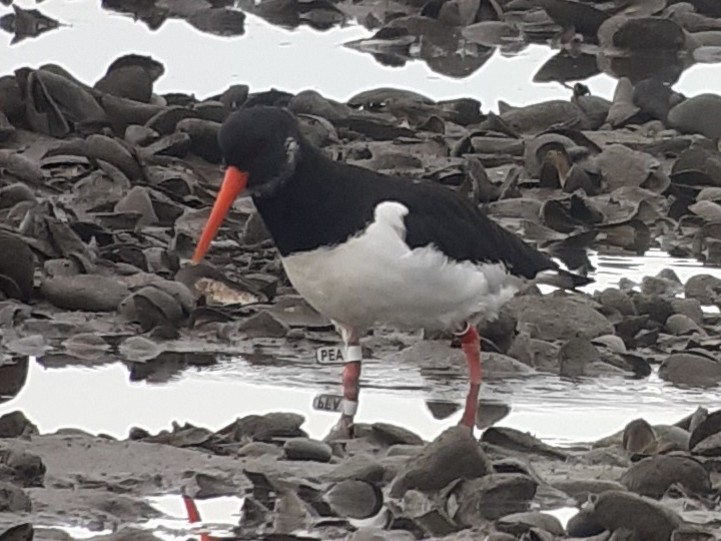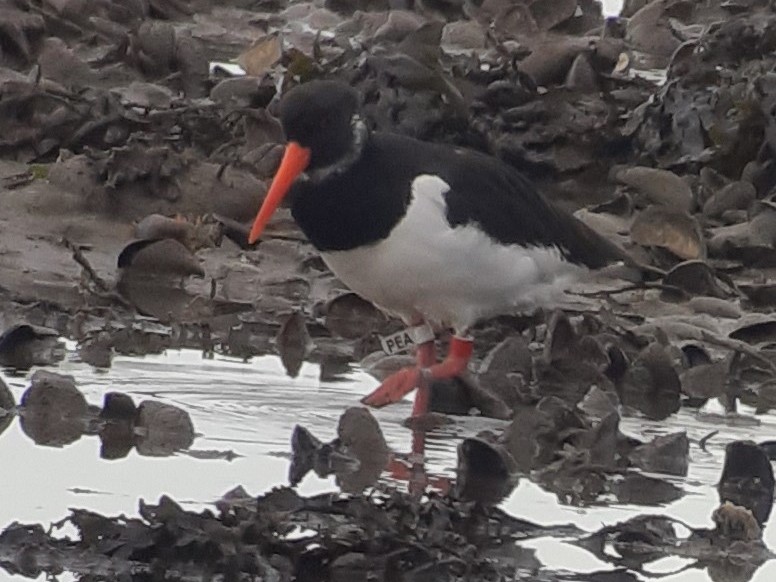Wader Sightings
A marked population, comprising field-readable rings unique to individuals, is a key component of our project as it enables investigation of individuals-based components of life history which would be impossible by any other means.
Ireland-wide wader ringing
We have colour-ringed a variety of species across the entire island of Ireland in both breeding and wintering periods. These include: Down/Antrim (Black-tailed Godwits at RSPB Belfast WoW; a variety of species at Strangford Lough, Dundrum Bay & Carlingford Lough), Derry (Oystercatcher on Lough Foyle), Donegal (Curlew on Lough Swilly & Trawbrega Bay), Clare (Purple Sandpiper, Turnstone & Sanderling: Quilty), Kerry (Tralee Bay: Redshank), Waterford (mostly Redshank, Grey Plover & Oystercatcher at Dungarvan), Louth (Curlew on Carlingford Lough) and north Dublin (see below). In the breeding season our colour-ring combinations have and are being used on Curlew (multiple counties), Redshank, Oystercatcher and Lapwing (mostly Tyrone & Donegal). Many thousands of birds!
North Dublin wader project:
Several species of wading bird have been caught and colour-marked in north Co. Dublin during the winters of 2021-2 and 2022-3. This is chiefly for a project with Fingal County Council and the University of Exeter, tracking the movements of three target species of shorebird: Redshank (Tringa totanus), Eurasian oystercatcher (Haematopus ostralegus), and Eurasian curlew (Numenius arquata). Subsets of the colour-marked birds have also been fitted with back-mounted GPS tags for fine-scale movement information. The aim of the project is to assess movement patterns and use of terrestrial habitats, particularly urban amenity grasslands, both within and outside the boundaries of the SPAs making up the Dublin Bay Biosphere reserve. The results will then be used by Fingal County Council to help inform town planning, with a view to ensuring adequate protection of important habitats throughout the birds’ home ranges. Any re-sightings of marked birds will contribute to our understanding of our study birds’ movement and migration patterns, and are greatly appreciated!
WHAT DETAILS DO I NEED TO RECORD?
The code on the flag or ring, and the colour of the scheme marker (plain colour ring), if present
Date, time and location of your sighting
Status of the bird (alive/dead/taken into care)
Flock size (if possible)
Below we show the scheme markers for three species - Redshank, Oystercatcher and Curlew. Note that we have also scheme markers operating for Bar-tailed Godwit, Dunlin, Greenshank, Ringed Plover and Lapwing; and we have used other scheme ring combinations for third-parties - Black-tailed Godwit (Pete Potts), Red Knot (Peter Knight et al.) and Sanderling (Jeroen Reneerkens). Information on our and other scheme markers are available here
Please click on the button below to submit your observations. There are tabs for each species and space to record the critical details such as location, date/time, your name etc.
NORTH DUBLIN TARGET SPECIES
Redshank
So far we have colour marked 187 redshank in north Dublin, 46 of which have been GPS tracked. Tracks so far have shown strong territoriality, with tagged birds remaining at or near the estuary at which they were initially caught and tagged for the whole winter season, with little mixing of birds between estuaries.
Look for: a white leg ring with a black three-letter code on the left tibia, and a yellow colour ring on the right tibia (see picture).
Oystercatcher
Over 1,000 oystercatcher have been colour marked across ROI and NI on this scheme, and 67 of the North Dublin birds have been GPS tracked. From the tags that remained on the birds long enough to track migration, we know that most of these birds migrate north in the spring, to the Hebrides, Shetland and Orkney, the Faroes and even Iceland.
Look for: a white leg flag with a black three-letter code on the right tibia, and EITHER red OR blue colour ring on the left tibia. IMPORTANT: please record whether the bird has a blue or a red colour ring on the tibia opposite the coded flag!



Curlew
Curlew are the newest addition to the Fingal project and a species experiencing rapid and widespread declines, and thus of high conservation priority. We have colour-marked 60 curlew at our North Dublin sites, 47 of which have been fitted with GPS tags.
Look for: a yellow leg ring with black two- or three-character code on the left tibia, and a blue colour ring on the right tibia. Breeding adults caught in Ireland normally have an additional plain white ring fitted on the tibia.
